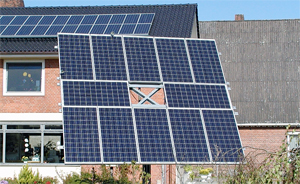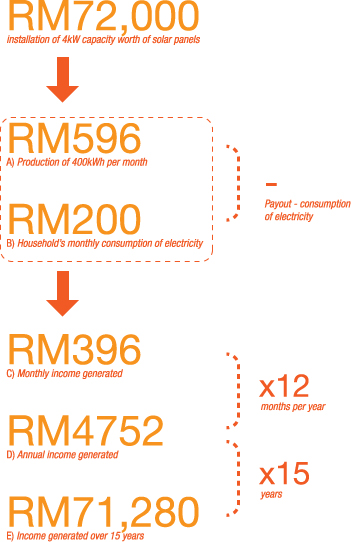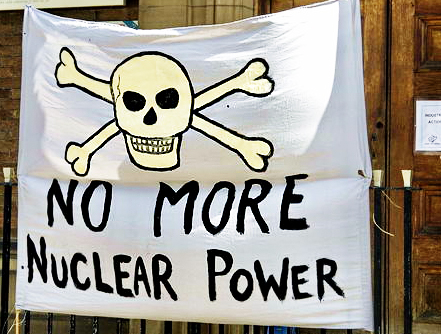 Have you ever wanted to install solar panels at your home, but couldn’t afford the capital cost? Once the Renewable Energy Act comes into force, this dream could become a reality.
Have you ever wanted to install solar panels at your home, but couldn’t afford the capital cost? Once the Renewable Energy Act comes into force, this dream could become a reality.
Passed by the Dewan Rakyat on 4 April 2011, the Act will allow individuals to sell electricity produced from renewable sources like solar photovoltaic at a higher rate than traditional power producers to Tenaga Nasional Berhad (TNB).
This incentive is expected to boost renewable energy industries and its current electricity generation share in the country from under one percent to 11% by 2020. But how will this work? Where will the funds come from? And will home-owning Malaysians be willing to be part of the new system?
Feed-in-tariff
Following the footsteps of pioneering country Germany and our neighbours Thailand and the Philippines, Malaysia will be implementing the feed-in-tariff (FIT) system.

Electricity produced from four types of sources — solar panels, small hydro, biogas and biomass — will benefit from the FIT mechanism under the Renewable Energy Act.
Among these four, residential homes would benefit most from solar photovoltaic as a renewable energy source.
The other three sources — small hydro, biogas and biomass, would be more suitable for implementation by businesses as the capital expenditure could amount to millions. The table below demonstrates the different costs involved in setting up the different sources.
| Solar PV | Small Hydro | Biomass | Biogas | |
| Installed capacity | 6kW | 10MW | 10MW | 4MW |
| Expenditure | RM90,000 | RM90mil | RM90mil | RM40mil |
Source: Adopted from Malaysia Building Integrated Photovoltaic Technology Application Project leader Ahmad Hadri Haris’s March 2011 presentation
Going solar at home

A normal household would usually need about 4kW capacity worth of solar panels, which would cost around RM72,000 to install. That’s about the price of a brand new Toyota Vios.
Too expensive to go green? Think again. Your Toyota Vios’s commercial value will be depreciating at a rate of about 10% a year, but not the income that you would be receiving from installing solar panels on your roof.
Under the FIT system, TNB will sign a 21-year agreement with households and pay at least RM1.49 per kWh electricity generated. Assuming production of 400kWh per month, this would amount to a payout of RM596 per month.
If a household’s electricity bill is RM200 a month, there would still be a steady monthly income of RM396 for the next 21 years, which could be used to repay the loan taken to install the solar panels. The 4kW system would pay for itself and start turning a profit within 15 years.
It is also worth highlighting that one will get paid more under the FIT mechanism if locally-manufactured or assembly solar inverters or photovoltaic modules are used, and/or used as part of building materials.
Granted, the scheme doesn’t bring about huge profits all at once, but I think most middle-class families would now be able to afford to install solar panels should they wish to.
However, it should also be noted that there will be an annual degression rate of 8% for the solar photovoltaic system. In other words, the later one joins the FIT scheme, the lower the FIT rate one will receive. This is based on the assumption that the cost of solar panels would go down once more people adopt it.
The degression rate will be reviewed every three years by the soon-to-be-established Sustainable Energy Development Authority to ensure the rates remain reasonable.
Making renewable energy commercially-viable
Residential homes aside, commercial renewable energy producers are the ones who are set to benefit the most from the FIT mechanism and who seem most excited about the new scheme.
Prior to the Act, TNB paid the same rate of RM0.21per kWh for energy whether or not it was produced from environmentally-friendly resources or from fossil fuel.
Under the FIT scheme, biogas and biomass electricity producers will finally be rewarded for their pioneering efforts and get paid at least 28% more than fossil fuel producers, as shown in the table below.
| Biogas | Basic FIT rate (RM) | Biomass | Basic FIT rate (RM) |
| Up to 4MW | 0.32 | Up to 10MW | 0.31 |
| Up to 10MW | 0.30 | Up to 20MW | 0.29 |
| Up to 30MW | 0.28 | Up to 30MW | 0.27 |
Source: Renewable Energy Bill
They will be signing a 16-year contract with TNB and enjoy the same competitive rates throughout the period.
In addition, those who use locally-manufactured or assembled gas engine or gastification technology will enjoy a bonus of one sen on top of their basic FIT rate.
Biogas electricity producers who use landfill or sewage gas as a fuel source will further enjoy a bonus of eight sen. Biomass players will enjoy an additional 10 sen for using municipal solid waste as their fuel source.
Already, a 26ha renewable energy park is being built on a remediated landfill in Pajam, Nilai, which would consist of a 2MW biogas plant and 8MW solar power facility, and is expected to generate RM12mil gross national income in 2020.
Meanwhile, small hydro producers enjoy less incentive at RM0.23 to RM0.24 per kWh but their contract with TNB will last for 21 years under the FIT mechanism.
Renewable Energy Fund
The government or TNB will not be forking out its own money to pay the higher FIT rates. The funds will come from consumers. There will be a one percent hike in the current electricity tariff, expected in 2012, the revenue of which will be used to finance the Renewable Energy Fund needed to finance the FIT scheme.
In other words, if your electricity bill is RM200, you will be paying an additional RM2 and that amount will go into the Renewable Energy Fund.
However, the FIT mechanism is not meant to last forever.
It is expected that the cost of producing renewable energy will eventually be cheaper than electricity currently produced by fossil fuel producers. This is also given the fact that current energy prices do not reflect the true cost of production due to subsidies for natural gas and the government-controlled electricity tariff. Once the cost of renewable energy drops below fossil fuel energy, the Renewable Energy Fund will cease to exist.
At that point, TNB would be able to directly purchase power from renewable energy producers as it would be cheaper than electricity produced from fossil fuel like gas and coal.

In the meantime, for the FIT mechanism to be implemented successfully, the government will need to widely publicise the new scheme to home owners and commercial producers and for many to participate in it. Only then will Malaysia be able to increase its renewable energy production to meet and hopefully, surpass its target of 11% by 2020. If Malaysia can push its renewable energy industries forward and make them cost-effective, not only would we be reducing our reliance on fossil fuel and carbon emission, we could even drop the idea of going nuclear, too. ![]()
Gan Pei Ling is looking forward to installing solar panels in her own home.


Chai Mien Seng says
Does the Renewable Energy [Act] also apply in East Malaysia like Sarawak, as the article only mentions TNB?
from Chai Mien Seng
Roxy says
Thanks for this article
Does this apply to all areas of Malaysia’s grid system? East and West Malaysia?
Gan Pei Ling says
Hi Roxy & Chai
The FIT is applicable to Sabah but Sarawak has its own electricity ordinance and rules. It is up to the Sarawak govt to decide if they wish to adopt the system, according to Ahmad Hadri Haris (chief technical advisor for RE/Malaysia Building Integrated Photovoltaic Technology Application (MBIPV) national project from the Ministry of Energy, Green Technology & Water)
cheers
Jacqueline Ann Surin says
In some countries like Holland, if you buy a hybrid car, you’re exempted from road tax and carbon emission tax which eventually makes it worthwhile to invest in green technology. I think the Malaysian government should also be looking at how we can make our vehicles greener since one of the biggest sources of carbon emissions is traffic.
Yin Shao Loong says
The federal government has offered a partial tax exemption for hybrid cars (at least the Prius) for the last 2 years or so. However, bear in mind that hybrid cars aren’t a silver bullet. All too often they are judged solely on fuel consumption and not their total life-cycle impact. Hybrid car batteries are highly dependent on toxic components (or components with toxic byproducts) such as rare earths. Currently, the Prius uses 1KG of neodymium and 10 to 15KG of lanthanum in the batteries and motors. Thus, the demand for the Lynas plant in Gebeng.
Even with various tax exemptions the base cost of a hybrid is still higher than average, meaning that its use would be confined to middle class buyers. Far better than hybrid cars would be an integrated public transport system that could slash emissions from single-occupancy vehicle travel.
THC says
The people have absolutely no idea what compromises must be made to shift to “alternate” energy. The solution is to reduce consumption. As you mentioned, more public transport. And less breeding to compensate for the longer lifespans humans enjoy.
JW Tan says
This is true, although in some countries the Prius batteries can be recycled. I’d also like to point out that large batteries are not the only use of neodymium, lanthanum and other rare earths. Anyone with a mobile phone, stereo speakers or headphones consumes products with rare earths in them, and the environmental impacts of these is even less well understood by the public at large.
I do drive a Prius (not in Malaysia) and it is a easy and fun car to drive. As petrol in my country of residence is not subsidised, it also saves me money, although it is only slightly better than a diesel engine in terms of fuel consumption. Upkeep and maintenance would be more expensive in Malaysia however, as the car effectively runs on electronics rather than physical levers and hydraulics.
I now realise that hybrid cars only tend to be popular in countries with high fuel prices, no matter how “cool” the marketing makes them out to be. So as long as Malaysia continues to subsidise fuel, few people bother to switch.
I think the Prius and other hybrids can be made more affordable to the Malaysian public, but eliminating the tariffs ought to close most of the gap.
C Lloyd says
Amen to a better integrated public transport system. That is what I am waiting for. As for photovoltaics…yes, please. More options for the people will never be a bad thing.
neptunian says
MS Gan,
Perhaps you should counter check the “facts and figures” from Hadzri, instead of swallowing wholesale and re-gurgitating to the public.
For Example :
1) 4 KW installed – [what does this mean?] It means 4KWp or peak production capacity is 4Kwh. The number of 400 KWp provided means that your panels are producing at peak rate for 3.3 hours per day, everyday of the month. This is not possible in Malaysia. Did Hadzri show you a daily chart for a year of at any experimental stations?
2) Solar panels efficiency degrades over time from a variety of causes:
a. Degradation of the cells themselves; and
b. Dirt coverage, reducing the actual amount of sunlight on the panels.
Pei Ling says
Hi neptuanian
1) It would depends on whether you’re using thin film or crystalline solar panels. Malaysia, with its cloud cover, is more suitable to use thin film but it is still not as widely available as crystalline/conventional ones. Ah, this reminded me, I must ask Hadri whether they would be promoting thin film alongside the FIT scheme.
2) Yes, as with all electrical items (including turbines and machines in power stations), the efficiency degrades over time, but I was thinking as more people adopt solar, services and jobs like solar panel cleaning and maintenance would increase alongside as well. But thanks for pointing this out as I did not include this point in my article.
neptunian says
Madam,
I think you are seriously mistaken about thin film solar. It is less efficient than crystalline solar panels. The reason for the shift to thin film is because of cost – both in production and in installation. The pricing given by Hadzri is thin film BIPV – you an check with him.
While you are at it, might as well get from him a daily power production chart (15 mins interval would do )for the last two months and publish it here. Would put things in perspective for yourself.
It would be nice for once if someone like you get all the facts before evangelising …. give the public a chance to make an intelligent choice.
Ng Ai Soo says
Pei Ling,
“I think most middle-class families would now be able to afford to install solar panels”
and for the others, for example the lower income groups:
“The funds will come from consumers. There will be a one percent hike in the current electricity tariff”
Do you think that is fair? Will the levy on consumers for the Renewable Energy Fund end there? Or will it become necessary to increase this as more and more of our middle-class decide to take up the offer to increase costs for all of us by installing solar panels?
Meanwhile, are there any maintenance costs for the solar panels over the 15 years before it pays for itself? And what is the life of the panels and what is the warranty period? Is there any reduction of performance of the panels with age? If so, is this payback scenario valid for those who implement solar at home under the scheme? Why not install 40kW rather than 4kW if such returns are gauranteed?
And finally, what is the life cycle carbon saving per kWhr from this scheme? Remember to include the backup requirement using our fossil fuel power stations. After all, carbon saving is the main reason to do this, is it not?
Pei Ling says
Hi Ai Soo
With a 1% across-the-board increase, lower-income groups whose electricity bill is say RM50/month will be paying an additional RM0.50/month. Meanwhile, those from the middle- or upper-class who consume more electricity (with more air-cons, TVs, computers etc at home) pay more. Is this fair? I would think it’s definitely fairer than if the govt decided to impose an additional RM10 charge on all consumers regardless of individual electricity consumption.
And if you read my piece and the Renewable Energy Bill correctly, the FIT rates offered decreases year-by-year as more people adopt the scheme. The FIT scheme, similar to social affirmative action policy, is not meant to last forever. It is merely meant to act as a catalyst to boast renewable energy adoption among the masses and industries. So if more people/businesses decide to set up solar, biogas, biomass and/or mini-hydro systems, resulting in the industries reaching economy of scale, the FIT scheme will be abolished. If the govt implements the scheme according to the bill, no extra levy should be necessary.
No, this is not just about carbon saving. Taking care of the environment is not just about cutting carbon emission but ensuring the sustainability of our current way of life. The way we’re consuming the Earth’s non-renewable natural resources and electricity now is definitely not sustainable. Energy efficiency and reduced consumption must come hand-in-hand with the promotion and adoption of renewable energy.
Ng Ai Soo says
Pei ling,
You mean that our industry will also be hit by the 1% levy?
If carbon saving is not the main issue, then our recent decision to go for a 1 GW coal-fired power station in Perak must be the right one. It may be just a little dirtier, much too dirty and carbon heavy for me, but in terms of cost it sure seems sustainable. It certainly is cheaper to all of us than solar, biogas, biomass and/or mini-hydro systems. Why not we allow other countries to try out these alternatives until they achieve economies of scale, then we buy cheap! For the time being, the prudent choice, it seems, since carbon is not the main issue, is to use coal. After all, we can always absorb back the CO2 by growing algae or planting trees… somewhere.
Ng Ai Soo says
Neptunian,
Can you please check my reasoning here:
The mechanism for measuring the feed-in will deduct the house consumption from the generated solar energy and bill the DIFFERENCE between the two for a given time interval. So the house will consume the solar electricity unless the generation exceeds the consumption within that time slot. If so, then the householder will be paid this difference in units. That means the expensive solar will first be consumed by the house, that is, the house will forego cheaper grid electricity in favour of the more expensive solar electricity. Earnings from the solar will therefore be based on the net electricity exported to the grid… which means the projected earnings above will not be realised even if generated by the solar installation…. and hence the payback may take longer than the 15 years projected above. So the middle class will be asked to generate and consume their own solar electricity expensively!
Right or not?
neptunian says
Hai Ng,
The details of the FiT is not published yet, but I suspect you may be right. The current version of the Build Integrated Photovoltaic (BIPV) installation actually just throws away the electricity not used by the household. There is no connection between the output from the BIPV to the mains. I have first-hand involvement with two such installations in Country Heights Damansara (5KwP).
With the current information, it is “NET metering” as you say, so the household must make more than it consumes… making it almost impossible to get any “NET”, so the payback period is NEVER.
For example :
Fridge (12 cu ft) – 1 Kwh
1 aircond – 1 Kwh
All electronic devices including computers, TVs, etc – 1 Kwh
Total 3 Kwh average, without lights if the house is occupied during the day when the sun is up. A 4KwP installation will only produce about 800W or 0.8 Kwh average, so you have a shortfall.
Hadzri never ever gives the whole picture, just like an advertiser or spin doctor. I really wish the solar people would paint a realistic scenario with figures to support their arguments, rather than hype and biased, vested-interest calculations.
There is a place for solar, but not subsidised BIPV in a grid-connected area.
neptunian says
Hai Ng,
I have just checked with my engineer in charge of the Build Integrated Photovoltaic (BIPV) installation for my house in Country Heights. TNB is now doing ‘net billing’, which means TNB calculates the total amount of power metered from solar, times unit value (FiT rate), then deducts the value of regular power times regular power rates. The user then pays the difference or receive credit as the case may be.
However, a fact that is NOT STATED, which I want to emphasise here very strongly, is that the BIPV-produced power is only metered. It is not connected to TNB’s incoming grid NOR is it connected to any load (devices that use electricity). We are still awaiting TNB’s instruction on the connection.
By thge way, the BIPV was installed over a year ago! How is that going to reduce the carbon footprint?
Ng Ai Soo says
Hey, Thanks Neptunian… you may have just saved the middle class there!
JEFFREY NG says
Can anyone tells me which government department – or is it TNB – is responsible for implementing this Renewable Energy Act? If I am interested in investing in a home system, which is the relevant department to go to?
neptunian says
It is “privatised”; just call up Greentech. They will direct you, but please do your maths carefully… or if you have extra money to burn, go ahead. However, I suggest buying a carton of books, stationery and goodies for some orphanage on a monthly basis… it’s better for your soul.
solar lights home says
We should all be looking to alternative energy forms.
kohlfuzion says
Folks, beware the GreenWash.
Neptunian, we’re in sync. Much of the hype about going green is just a load of hot air. People should wise up to some of the myths and axioms being perpetuated, ostensibly for the greater good, but in reality [a] hidden agenda, knowingly or unwittingly. Some facts to go by:
1) The earth was much warmer and happier aeons ago, and there were no carbon belching cars or power stations then.
2) We are at the tail end of an ice age, so of course many places are going to warm up.
3) We have deserts because of [the] ice age; a warmer earth would be more verdant and productive.
4) Fighting climate change is the biggest oxymoron in greenwash; it’s an affront to all. Instead of taxing and spending to fight climate change, it would make more sense getting ready to embrace a warmer, wetter world.
5) People are the cause of environmental degradation only because of the politicians and politics that we allow to dominate our lives.
Thurman Esch says
Certainly, but everyone needs to realise that adding solar on their house is a purchase which will increase the future worth of their home if / when they decide to sell. With the environment the way it is going we cannot disregard any system that supplies free energy at no cost to both the customer and more notably the earth!